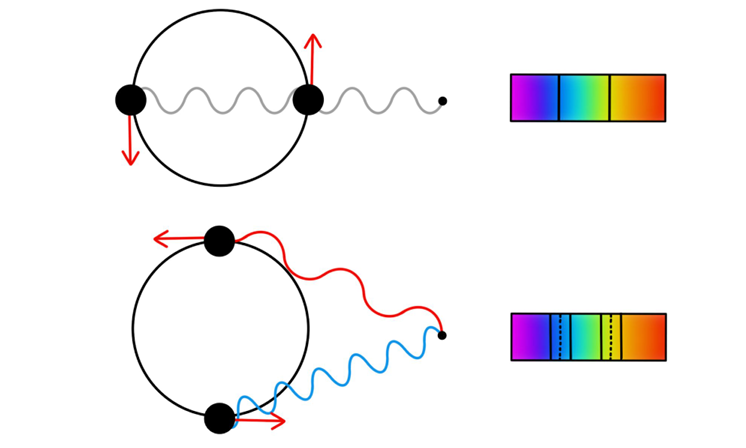Astrophysics
1/52
Earn XP
Description and Tags
Name | Mastery | Learn | Test | Matching | Spaced |
|---|
No study sessions yet.
53 Terms
Ray Diagrams
Rays of light that pass through the middle of the lens do not reflect.
Rays parallel to the principle axis will refract through the focal point.
Rays travelling through the focal point before the lens will exit parallel to the principle axis.
Power of a lens
P = 1/ f
Refracting Telescopes
Comprised of two converging lenses
Objective lens collects light from stars and creates a real image at its focal point.
The eyepiece magnifies the image produced, creating a virtual image at infinity.
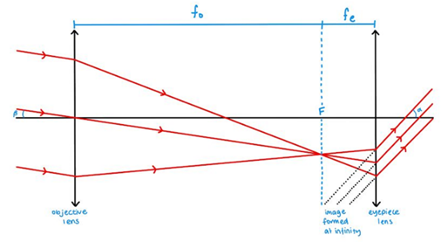
Normal Adjustment
The distance between the two lenses in a refracting telescope is the sum of their focal lengths, so their focal points are in the same place.
Magnifying Power / Angular Magnification
M = angle subtended by image / angle subtended by object
Reflecting Telescopes
A concave primary mirror with a long focal length focuses the light.
A small convex secondary mirror positioned near the focal point reflects the nearly focused light.
An eyepiece lens refracts the light so it enters the eye parallel and forms a virtual object at infinity.
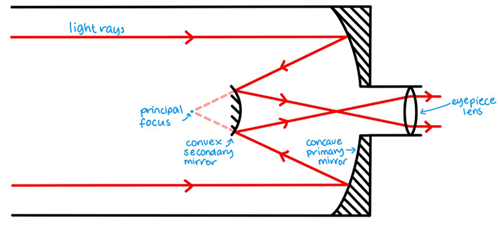
Spherical Abberation
Curvature of the lens or mirror means rays to be focused on different points, causing image blurring and distortion
Chromatic aberration
Different wavelengths of light are distracted by different amounts, causing coloured fringing around the edge of the image. This can be solved using a second conclave lens to focus all the light.
Advantages + Disadvantages Refracting Telescopes
Chromatic and spherical aberration.
Large lenses bend and distort under their own weight.
Large magnifications require very large diameter objective lenses with long focal length.
Has greater angular magnification for same length.
Advantages + Disadvantages Reflecting Telescopes
Spherical aberration.
Mirrors are light and easy to handle.
Large composite primary mirrors can be made from lots of smaller mirror segments.
Easier to support as mirrors can be supported from behind.
Have a wider field of view for the same length.
Collecting Power
Measures the amount of light energy collected per second. It is directly proportional to the square of the objective’s diameter.
Resolving Power
The smallest angular separation that an instrument can distinguish between two objects.
Rayleigh Criterion
Two sources will be just resolved if the central maximum of the diffraction pattern of one coincides with the first minimum of the other.
Charge-coupled devices
An array of light-sensitive pixels which are highly sensitive to photons. Incident photons cause electrons to be released, with the number of electrons released proportional to the intensity of incident light.
Advantages of CCDs
Higher quantum efficiency
Can operate over a wider range of wavelengths
Can resolve images more clearly as have higher pixel resolution
Images can be shared and stored
Can be time exposed to produce brighter images
Telescopes at Ground Level
Can observe:
Visible Light
Some IR
Most microwave
Most radio waves
Radio telescopes
Because radio wavelengths are much larger than visible, they require a much larger diameter to achieve the same resolving power.
Wire mesh instead of mirrors.
Study galaxies and map the milky way by studying 21cm radio waves produced by hydrogen atoms.
IR Telescopes
Large concave mirrors focus radiation onto a detector.
Study cooler regions in space, such as dust clouds.
Often launched into space.
UV Telescopes
Only found in space.
Map star formation regions and other hot objects in space.
X-ray Telescopes
Only found in space.
Consist of parabolic and hyperbolic mirrors.
Observe active galaxies, black holes and neutron stars.
Gamma Telescopes
Only found in space.
Observe quasars, black holes and gamma ray bursts.
Advantages of Satellite Telescopes
No absorption of electromagnetic waves by the atmosphere.
No light pollution or other sources of interference.
No optical effects, such as scattering or scintillation.
Astronomical Unit
Average distance between the earth and sun.
Light Year
Distance light travels through space in a year.
Parsec
Distance at which the angel of parallax is 1 arcsond.
Parallax
The apparent change of position of a star in comparison to more distant stars as a result of the orbit of the Earth. Only works for distances of about 100pc, because beyond this angles are too small to accurately measure.
Magnitude Equation
m = M + 5log(d/10)
Black Bodies
Objects that are perfect emitters and absorbers of all possible wavelengths. Can be used to deduce Wein’s and Stephen’s Laws.
Wien’s Law
Peak wavelength of emitted radiation is inversely proportional to the absolute temperature.
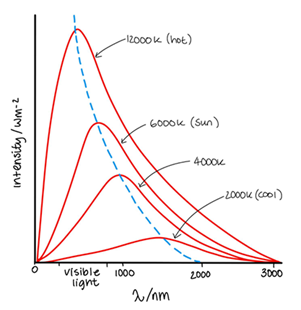
Inverse Square Law
I = P / (4*pi*d²)
Hydrogen Balmer Absorption Lines
Caused by the excitation of hydrogen atoms from the n = 2 state to higher energy levels, which requires very high temperatures. Found in O, B and A stars.
Spectral Classes
Spectral Class | Colour | Temperature (K) |
O | Blue | 25,000 – 50,000 |
B | Blue | 11,000 – 25,000 |
A | Blue / White | 7,500 – 11,000 |
F | White | 6,000 – 7,500 |
G | Yellow / White | 5,000 – 6,000 |
K | Orange | 3,500 – 5,000 |
M | Red | < 3,500 |
Hertzsprung-Russel Diagram
Plots temperature against magnitude.
Logarithmic temperature scale from 50,000 to 2,500.
Absolute magnitude scale from +15 to -10.

Protostars
Clouds of gas and dust.
Contract under gravitational attraction.
As they rotate, they spin inward to form a denser centre so temperature increases.
Eventually nuclear fusion occurs.
Outer layer of protostar becomes hot and a photosphere is formed.
Main Sequence
Helium fused into hydrogen.
Gravity balanced by radiation pressure.
Red giant and Supergiant
Under 3 solar masses: red giant.
All hydrogen has been fused.
Core collapses and outer layers expand.
When the core is dense enough, helium fusion begins to occur.
White Dwarf
Under 1.4 solar masses
When helium used up, core contracts.
Electron pressure balances gravitational pressure.
Planetary nebula.
Supernova
Above 1.4 solar masses.
Star collapses until it has the density of atomic nuclei.
Core suddenly becomes rigid.
Collapsing matter rebounds, releasing so much energy that elements heavier than iron can be fused.
Neutron Star
Between 1.4 and 3 solar masses.
Protons and electrons become neutrons.
Density of nuclear matter.
Pulsars are spinning neutron stars that emit beams of radiation from their magnetic poles.
Black Hole
Greater than 3 solar masses.
Neutron pressure isn’t strong enough to withstand gravitational force.
Escape velocity greater than the speed of light.
Event horizon = point at which escape velocity is greater than the speed of light.
Supermassive Black Holes
Formed by
The collapse of massive gas clouds as the universe was forming.
A normal black hole that accumulated huge amounts of matter over millions of years.
Several black holes merging together.
Type I Supernovae
No strong hydrogen lines, occur when a star accumulates matter from its companion star and explodes after reaching critical mass.
Type II Supernovae
Occur at the death of a high mass star.
Type 1a Supernova
White dwarf star begins to accumulate the mass of a companion giant star. When the white dwarf reaches critical mass, fusion begins and becomes unstoppable, causing the white dwarf to explode. Can be used as standard candles.
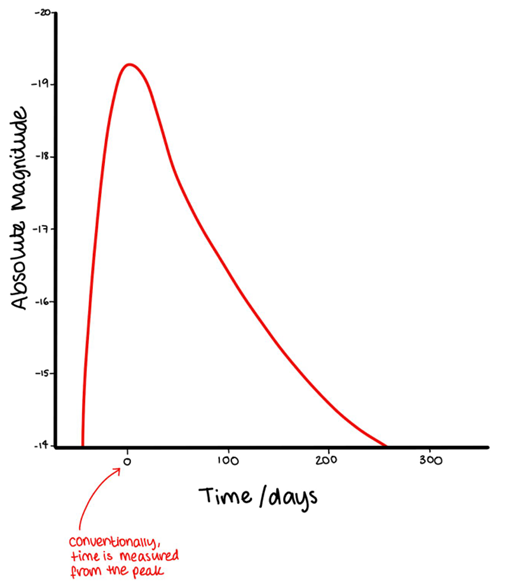
Eclipsing Binaries
Stars are beside one another.
Smaller star eclipses the larger one, brightness at a minimum.
Larger star eclipses the smaller one, brightness decreases to a lesser degree.
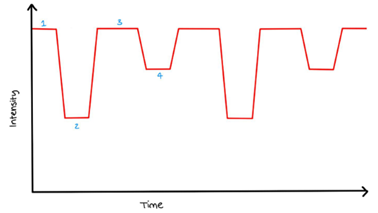
Hubble Law
The further away a galaxy is from us, the greater the redshift of stars within it. This can be found using the equation v = Hd, where H, the Hubble Constant, is measured in km s-1 Mpc-1
Age of the Universe
1 / H = d / v = t
Proof for the Big Bang
CMBR: Remaining high-energy radiation from the Big Bang, which has redshifted over time.
Relative abundances of hydrogen and helium.
Dark Energy
The rate at which the universe is expanding is accelerating, so scientists have theorised the existence of dark energy.
Quasars
Oldest and most distant objects in the known universe.
Active galactic nuclei.
Only found at great distances, suggesting they existed in the early universe and confirming its evolutionary nature.
They have extremely large optical redshifts, very powerful light output and a relatively small size.
Transit Method
Measure the light intensity of a star.
A regular dip in intensity can be observed when the planet transits the star.
Size and orbital period of the planet can be determined by amount of intensity drop and its duration.
Radial Velocity
Measure the Doppler shift in light received by a star as it orbits around a barycentre.
Time period of Doppler shift cycle equal to time period of planets rotation.
Only works for high mass planets orbiting near their star.
Spectroscopic Binaries
Binary star system in which the stars are too close to be resolved by a telescope.
When the stars eclipse one another, they travel perpendicular to the line of sight, so there is no Doppler shift in emitted radiation.
When the stars are travelling in opposite direction, the spectral lines split into two, with one red-shifted and one blue-shifted.
